|
|
||||
|
Published by : PROFESSIONAL MEDICAL PUBLICATIONS |
||||
|
ISSN 1681-715X |
||||
|
||||
|
- |
||||
|
ORIGINAL ARTICLE- |
||||
|
- |
||||
|
Volume 25 |
April - June 2009 (Part-I) |
Number 2 |
||
|
|
||||
|
|
||||
|
|
||||
|
Published by : PROFESSIONAL MEDICAL PUBLICATIONS |
||||
|
ISSN 1681-715X |
||||
|
||||
|
- |
||||
|
ORIGINAL ARTICLE- |
||||
|
- |
||||
|
Volume 25 |
April - June 2009 (Part-I) |
Number 2 |
||
|
|
||||
|
|
||||
Belief in prayers and its role in healing among
family practice patients visiting a teaching
hospital in Karachi, Pakistan
Waris Qidwai1, Rumina Tabassum2, Raheela Hanif3, Fahad Hanif Khan4
ABSTRACT
Objectives: To document the practice and belief in offering prayers to have a favorable impact on healing among family practice patients at a teaching hospital in Karachi.
Methodology: This study was conducted at Community Health Centre, Aga Khan University Hospital, Karachi, Pakistan in July 2008. A questionnaire was designed that included the demographic profile of patients comprising age, sex, marital status, religion, religious sect, ethnic group, education & occupation as well as questions in accordance with the study objective. It was administered to 400 patients visiting outpatient department of the hospital against calculated sample size of 385. Participants were explained the study objective, a written consent was taken and full confidentiality was assured.
Results: The mean age of the study population was 34.33 years, majority of the patients were males (65%) with 65.6% having grade XII or more education. The majority of subjects was Urdu-speaking (76.5%) and belonged to Sunni sect (81.3%). The practice of offering prayers for healing was found statistically significant with Sindhi, Katchi, Haro & Kashmiri groups (p-value=<0.001 each); religious sects of Sunni (p-value=0.002) & Ismaili (p-value=<0.001) & with students (p-value=0.005). The number of "Shia" sect participants was small but they all had offered prayers for healing. This practice was not found statistically significant with gender, marital status and education. Prayers for healing is practiced by 96.5% of the participants and 95.8% believe that it does cause healing. Almost ninety three percent of participants believe that religion gives us the concept of healing through prayers. According to 97.5% of the participants medical treatment should be combined along with prayers for healing.
Conclusion: Prayer, its practice and belief in having a favorable impact on healing and recovery from illness is widespread among family practice patients. Modern day clinicians must give due consideration to this practice and belief among their patients.
KEYWORDS: Healing, Prayers, Alternative medicine, Complementary medicine.
Pak J Med Sci April - June 2009 Vol. 25 No. 2 182-189
How to cite this article:
Qidwai W, Tabassum R, Hanif R, Khan FH. Belief in prayers and its role in healing among family practice patients visiting a teaching hospital in Karachi, Pakistan. Pak J Med Sci 2009;25(2): 182-189
1. Dr. Waris Qidwai, FCPS,
Professor and Chairman,
Family Medicine,
The Aga Khan University, Karachi
2. Dr. Rumina Tabassum, FCPS,
Associate Professor,
Gynecology & Obstetrics,
3. Ms. Raheela Hanif,
Medical Student,
4. Mr. Fahad Hanif Khan,
Medical Student,
2-4: Dow University of Health Sciences,
Karachi – Pakistan.
Correspondence
Dr. Waris Qidwai,
Professor and Chairman,
Family Medicine,
The Aga Khan University,
Stadium Road, P.O. Box: 3500,
Karachi 74800, Pakistan
E-Mail: waris.qidwai@aku.edu
* Received for Publication: November 12, 2008
* Accepted: January 31st 2009
INTRODUCTION
Both "cure" & "heal" are words used interchangeably to mean restoration of health. Healing in a patient takes place through a process that draws upon powers of nature, science & physician.
1Prayer is defined by the National Centre for Complementary & alternative Medicine (NCCAM) as an active process of appealing to a higher spiritual power, specifically for health reasons; it includes individual or group prayer on behalf of oneself or others.
2 Although prayer is one of the most ancient of healing practices, the scientific literature studying prayer is still quite young. In this setting, the cultural practices of patients, families, and medical staff frequently include the personal use of prayer or solicitation of prayer with therapeutic intention from other devotees.3The term alternative medicine, as used in the modern western world, encompasses any healing practice that does not fall within the realm of conventional medicine.
4 It is frequently grouped with complementary medicine, which generally refers to the same interventions when used in conjunction with mainstream techniques,5-7 under the umbrella term complementary and alternative medicine, or CAM. It is a broad domain of resources that encompasses health systems, modalities, and practices and their accompanying theories and beliefs, other than those intrinsic to the dominant health system of a particular society or culture in a given historical period. CAM includes such resources perceived by their users as associated with positive health outcomes. Boundaries within CAM and between the CAM domain and the domain of the dominant system are not always sharp or fixed.8Proponents of spirituality claim that prayer can decrease the negative effects of disease, speed recovery, and increase the effectiveness of medical treatments. Faith and religious beliefs are also thought to improve coping and provide comfort during illness. Religious attendance is sometimes linked with improvement of various health conditions such as heart disease, hypertension, stroke, colitis, uterine and other cancers, and overall health status. Scientific evidence is inconclusive.
9 Prayers are sometimes for divine intervention to achieve specific health outcomes, such as fewer postoperative complications or shorter hospital stays.10 Many medical practitioners consider spirituality and prayer as important components of healing.9Spirituality has many forms and can be practiced in many ways. Prayer, for example, may be silent or spoken out loud and can be done alone in any setting or in groups (as in a church or temple). Regular attendance at a church, temple, or mosque may involve prayer which focuses on one’s self (supplication) or on others (intercessory prayer). In this type of setting, the entire congregation may be asked to pray for a sick person or the person’s family.
9A survey of issues of the Journal of Family Practice spanning 10 years found that 83% of studies on religiosity found a positive effect on physical health.
11 At the present time, there is a widening search for spirituality as distinct from organized religion, particularly as it relates to well-being, wholeness, and healing. In both professional and lay contexts, spirituality has come to the forefront of public consciousness.12A large proportion of published empirical data suggest that religious commitment shows positive associations with better mental and physical health outcomes. There are relatively few studies showing no effect or negative effect of religiosity (measured by participation in religious ceremony, social support, prayer, and belief in a higher being.
11) on health outcomes.13 This study is directed to document belief in prayers positively affecting healing and practices and perception of prayers in relation to healing.METHODOLOGY
This is a questionnaire based cross-sectional survey conducted at the Community Health Centre of Aga Khan University Hospital, Karachi, Pakistan in July 2008. On an average, 200-250 family practice patients with primary and secondary care level problems are seen daily by twelve family physicians at the centre.
A questionnaire was developed by the investigators after extensive literature search, including input from colleagues & patients. The questionnaire included the demographic profile of patient including age, sex, marital status, education, occupation, ethnic group & religious sect. Questions were developed at exploring patients’ perceptions regarding healing effect of prayers; the way they prefer to practice it & its role in combination with modern medicine.
It was administered in English & Urdu depending on patient’s comfort. The investigators interviewed the patients & filled out the questionnaire. A pilot study was conducted prior to the initiation of the administration of the final questionnaire.
An agreement was reached between the investigators on how to administer the questionnaire, in order to ensure the uniformity in filling of the questionnaire. The questionnaire was administered in the waiting area outside the physician’s office prior to the consultation. Patients who agreed to participate in the study regardless of family physician they consulted were enrolled in the study. The interviews were conducted throughout the month & no specific timings were followed. Ethical requirement including the administration of written informed consent & the provision of confidentiality were ensured.
We interviewed participants based on their availability & convenience. Epi data version 3.0 & SPSS version 16.0 were used for data entry & management respectively.
RESULTS
A total of four hundred participants were interviewed. The mean age of study population was 34.3 years, majority of the subjects were married (62.8%), and female to male ratio was 1:1.85 with 65.6% having grade XII or more education. The majority of respondents were housewives (27.8%), followed by those in private service (25.3%), students (16.3%) & self-employed (16%). Majority of respondents were Urdu speaking (76.5%) & 81.3% belonged to Sunni sect. (Table-I)
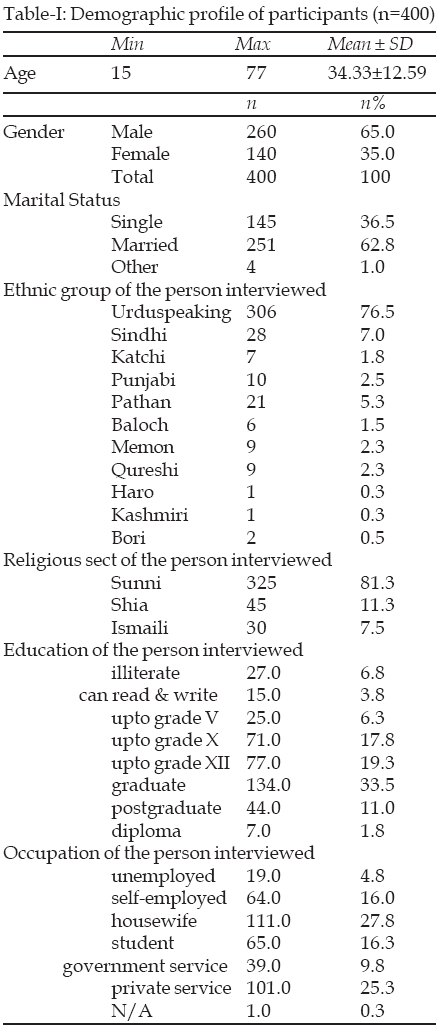
The offering of prayers was not statistically significant in relation to gender (p-value = 0.473), marital status & educational level. In ethnic group, offering of prayers was found statistically significant in Sindhi, Katchi, Haro & Kashmiri groups (p-value=<0.001). Sunni & Ismaili sects were statistically significant in relation to the practice of offering prayers for healing with p-values of 0.002 & <0.001 respectively. The number of "Shia" sect participants was small but they all had offered prayers for healing. In occupation, this practice was statistically significant in students only (p-value=0.005) (Table-II).
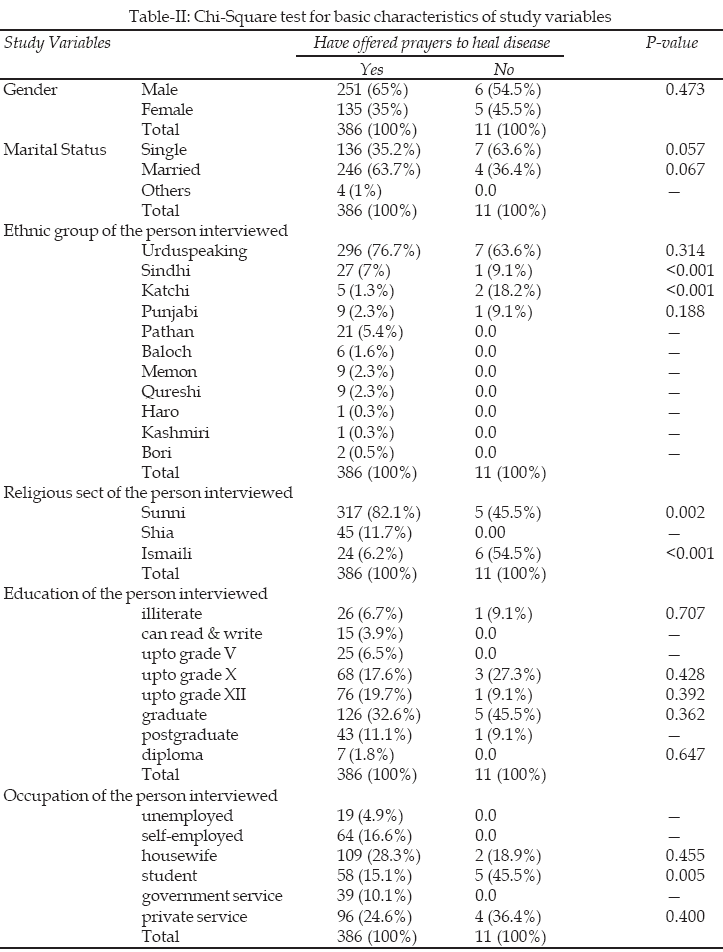
Scatter diagram shows uniform practice of offering prayers for healing irrespective of age (Figure-1).
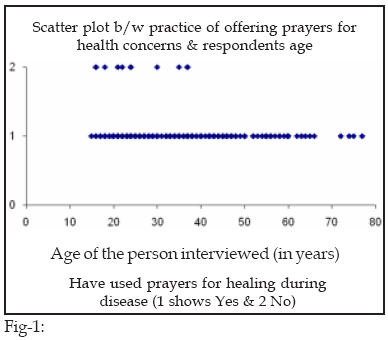
Prayers have healing properties according to 95.8% respondents & 90% have experienced healing through prayers. According to 92.3%, the concept of healing through prayers was given by religion. (Table-III)
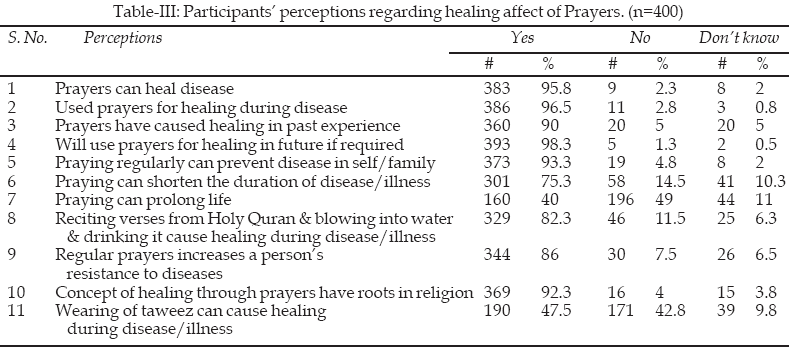
Prayers for healing were mainly said after Namaz (97%) & in the form of reading verses from Holy Quran (64.5%). These prayers were offered in isolation (42.8%) and in isolation and collectively both (46.2%) in which 97.5% cases directly address God. (Table-IV)
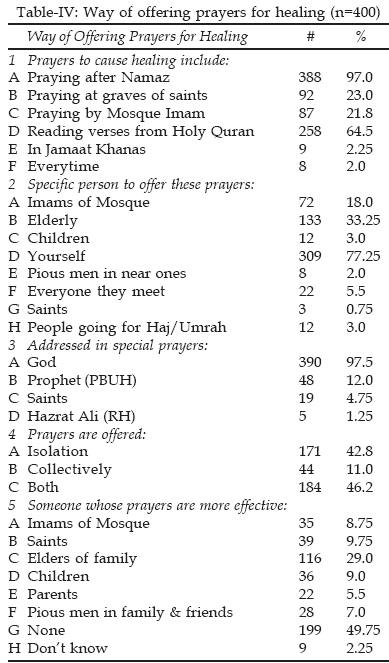
Medical treatment should accompany prayers for healing said 97.5% of the respondents. 73.8% said medicine should take account of prayers as healing method. 64.5% respondents, said prayers & medicine are equally important for recovering from disease (Table-V).
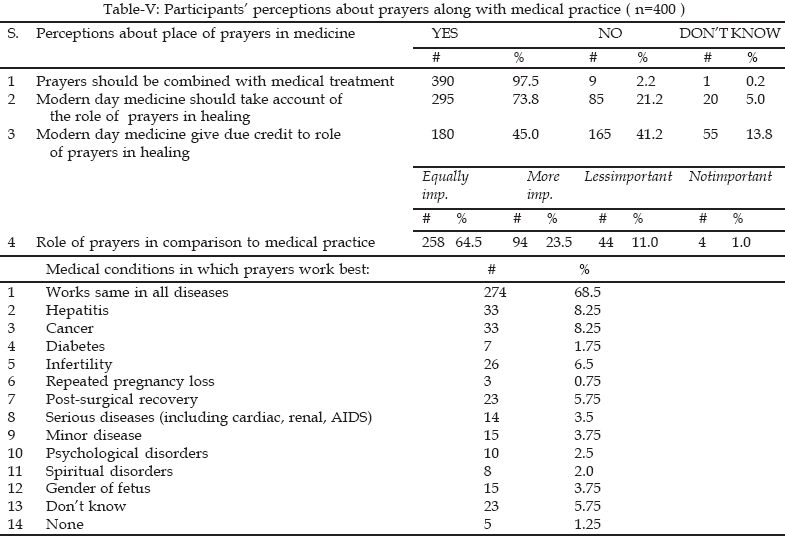
DISCUSSION
As interest in Alternative and Complementary medicine (CAM) has grown in the recent years and the notion of linking of religious and medical interventions has become widely popular.
14 Prayer is the most common therapy used among all the CAM therapies.2 We have attempted to document patients’ and their attendants’ perceptions on healing affect of prayers; how they ought to offer them & place of new developing concept of healing through prayers in modern medicine.In our survey, the practice of offering prayers for healing purpose is not found to have statistically significant association with gender (p-value=0.473). In 2002, a US survey showed the largest gender differential was seen in prayers with women more likely to use it and use of prayers for health reason did not increase with educational level.
15In our study, use of prayers for health reason was statistically significant with Sindhi, Katchi, Haro & Kashmiri ethnic groups (p-value, 0.001); Sunni (p-value0.002) & Ismaili (p-value=<0.001) sects & in occupation with students (p-value=0.005).
It is interesting to note an overwhelming majority of the respondents (95.8%) believe that prayers can heal disease. Similarly a recent poll found that 82% of Americans believe that prayer can cure serious illness.
16 We found that 96.5% participants had used prayers for healing during disease. In 2002, a US survey showed 74.6% had used some form of CAM therapy and this figure decreased to 49.6% when prayer for health reason was excluded.15 We found that 360 (90%) respondents had experienced healing because of prayers. In a Harvard Medical School Study, out of 35% respondents who had used prayers, 70% reported prayer to be very helpful.17 We have found that 98.3% subjects will use prayers for healing in future if need arose and 92.3% believe that the concept of healing by prayers is given by their religion.It is noteworthy that 93.3% of the participants said that regular praying can prevent diseases in self and family. Another analysis of 350 studies has found that religious people are physically healthier, lead healthier lifestyles and require fewer health services.
18Interestingly, we have found that three-fourth (75.3%) of those interviewed believed that prayers can shorten the duration of disease, but with regards to length of life, 49% participants believed that it is not prolonged by prayers. It is equally important to realize that 160 (40%) participants believe that prayers can prolong life. It is already known that there is an inverse relationship between religious attendance and mortality
18 and scientific evidence is strongest for the religious attendance–mortality association.19With regards to how prayers for healing are offered, 97% participants pray for health after Namaz followed by reading verses from Holy Quran (64.5), at graves of saints (23%) & by mosque Imams (21.8%). Any specific time to offer prayers for healing was not found statistically significant.
God is directly addressed by 390 (97.5%) participants when praying for health. In Shia school of thought, the prayer is directed to God, but mention is made of someone or something beloved to God.
20 The Prophet (PBUH) and saints are also addressed in these special prayers by 12% & 4.75% respondents respectively.A substantial number of respondents (42.8%) prefer to pray in isolation while 46.2% pray for returning to normal health in both isolation and collectively. According to a US survey, almost 10 percent had participated in a prayer group for their health.
2Almost 77.25 % of the participants prefer to offer these prayers themselves & 5.5% ask everyone they meet as a gesture. Again 45.2% had in the last twelve months used prayer for health reasons, either through praying for their own health or through others praying for them.
15 They also ask elders of family (33.25%), Imams of Mosque (18%), people going for Hajj/Umrah (3%) & children (3%) with the traditional idea that their prayers are answered more quickly & frequently. A survey in US revealed that 25 percent requested others to pray for them.2Almost half of the respondents said that they don’t have any experience that someone’s prayer was more effective than their own. Other participants consider that prayers of elders of the family (29%), saints (9.75%), children (9%), Imams (8.75%) & pious men in family & friends (7%) are much more effective than theirs. In a CNN poll, 73% believe that praying for others can cure illness.
16Inquiry in respondents’ perception about prayers role in increasing resistance against diseases reveals that 86% agreed that it affects immune system. Studies have found that religion is positively related to immune system function.
21 Currently research is in progress to determine link between immune function and spirituality by measuring IL-6 levels in blood.2There are other methods used for healing by our study partcipants and include: reciting verses from Holy Quran, blowing them on water and then drinking it (82.3%) and wearing of taweez (thread or ornament with air blown into it after reading Holy Quran) is thought to prevent or cause faster healing during disease by 47.5% participants. Almost 42.8% respondents refuse to acknowledge any role to taweez in healing or curing diseases.
Interestingly, 97.5% of participants believe that prayers should be combined with medical treatment indicating that it is taken as complementary approach rather than alternative one; as literature supports relying on this type of treatment alone, and avoiding or delaying conventional medical care, may have serious health consequences.
9 In 2002 in US, 54.9% used CAM in conjunction with conventional medicine.15 Role of prayers for healing in comparison to medical treatment was equally important for 64.5% & more important for 23.5% participants.A great majority of subjects (73.8%) said that modern medicine should accept role of prayers in curing & healing diseases. Forty five percent responded that modern medicine does take account of prayers as healing method but 41.2% disagreed on this matter. Many patients and their healthcare providers believe that faith-based prayers
to God are important instruments for healing.22 Two hundred ninety six physicians were surveyed during the October, 1996, at the meeting of the American Academy of Family Physicians. Almost 99% were convinced that religious beliefs can heal, and 75% believed that prayers of others could promote a patient’s recovery. Benson writes that faith in God has a health-promoting effect.23 In another study, 68% said their physician had never discussed religious beliefs with them & 48% want their physicians to pray with them.24Participants’ response when asked about disease in which prayers work best, majority (68.5%) had the view that it works same in all diseases; others responded in favor of hepatitis (8.25%) & cancer (8.25%). Various studies have found that prayers have better outcomes for hypertension,
25-27 cardiovascular diseases,28 pregnancy,29 pain,30 depression,31-34 protective effect for mental health outcomes35 & cancer.36CONCLUSION
The study shows that a majority of the participants believe prayers have healing properties of their own as alternative medicine still they are optimistic to combine it with medical treatment making it a complementary one. We as physicians must try to improve our ability to act as healers by giving importance to holistic approach to medical practice. Further debate & studies on this important issue are strongly recommended.
REFERENCES
1. Szawarski Z. Wisdom and the art of healing. Med Health Care Philos 2004;7(2):185-93.
2. http://nccam.nih.gov/news/newsletter/2005_winter/prayer.htm
3. Mitchell W. Krucoff, Suzanne W. Crater, Kerry L. Lee. From efficacy to safety concerns: A STEP forward or a step back for clinical research and intercessory prayer? The Study of Therapeutic Effects of Intercessory Prayer (STEP). 2006;151(4):762-4.
4. Bratman MD, Steven. The Alternative Medicine Sourcebook. Lowell House,1997;7.
5. White House Commission on Complementary and Alternative Medicine Policy, March 2002;Chapter 2.
6. Ernst E. Complementary medicine: Common misconceptions. J Royal Society Med 1995;88(5):244-7.
7. Joyce CR. Placebo and complementary medicine. Lancet 1994;344(8932):1279-81.
8. Board on Health Promotion and Disease Prevention of the Institute of Medicine. "Complementary and Alternative Medicine in the United States". National Academies Press. 2005
9. http://www.cancer.org/docroot/ETO/content/ETO_5_3X_Spirituality_and_Prayer.asp
10. Churchill LR. The dangers of looking for the health benefits of religion. Lancet 2007;369:1509-10.
11. US Congress, Office of Technology Assessment. Unconventional Cancer Treatments. Washington, DC: US Government Printing Office; 1990. Publication OTA-H-405.
12. Chandler E. Spiritulity. Hosp J 1999;14:63-74.
13. Aukst-Margetić B, Margetić B. Religiosity and health outcomes: review of literature. Coll Antropol 2005;29(1):365-71.
14. Sloan RP , Bagiella E, Powell T. Religion, spirituality, and medicine. Lancet – 1999;353(9153):664-7.
15. Barnes PM, Powell-Griner E, McFann K, Nahin RL. "Complementary and Alternative Medicine Use among Adults: United States, 2002". National Center for Health Statistics. 2002.
16. Ameling A. Prayer: an ancient healing practice becomes new again. Holist Nurs Pract 2000;14(3):40-8.
17. McCaffrey AM, Eisenberg DM, Legedza AT. Prayer for health concerns: results of a national survey on prevalence and patterns of use. Arch Intern Med 2004;164:858-62.
18. Hummer R, Rogers R, Nam C, Ellison C. Religious involvement and US adult mortality. Demography 1999;36:273-85.
19. Lee BY, Newberg AB. Religion and health: a review and critical analysis. Zygon 2005;40:443-68.
20. En.wikipedia.com
21. Pargament KI, McCarthy S, Shah P. Religion & HIV: A review of the literature & clinical implications. South Med J 2004;97:1201-9.
22. Cathy Creger Rosenbaum. The Role of the Pharmacist—Prayer and Spirituality in Healing. The Annals of Pharmacotherapy 41(3);505-7.
23. Benson H. Timeless Healing. New York: Fireside, 1996.
24. King DE, Bushwick B. Beliefs and attitudes of hospital inpatients about faith healing and prayer. J Fam Pract 1994;39(4):349-52.
25. Al Kandari YY. Religosity & its relation to blood pressure among selected Kuwaitis. J Biosoc Sci 2003;35(3):463-72.
26. Frequency of attendance at religious services, hypertension & blood pressure: The 3rd National Health & Nutrition Examination survey. Psychosom med 2006;6893:382-5.
27. Walsh A. Religion & hypertension: Testing alternayive explanations among immigrants. Behav Med 1998;24(3):22-30.
28. Byrd RC. Positive therapeutic effects of intercessory prayer in a coronary care unit population. South Med J 1988;81:826-9.
29. Cha KY, Wirth DP. Does prayer influence the success of in vitro fertilization-embryo transfer? Report of a masked, randomized trial. J Reprod Med 2001;46:781-7.
30. Koenig HG. An 83-year-old woman with chronic illness and strong religious beliefs. JAMA 2002;288:487-93.
31. Smith TB, McCullough ME, Poll J. Religiousness and depression: evidence for a main effect and the moderating influence of stressful life events. Psychol Bull 2003;129:614-36.
32. Razali SM, Hasanah CI, Aminah K. Religious–sociocultural psychotherapy in patients with anxiety and depression. Aust N Z J Psychiatry 1998;32:867-72.
33. D’Souza R, Rodrigo A. Spiritually augmented cognitive behavioural therapy. Australas Psychiatry 2004;12:148-52.
34. Townsend M, Kladder V, Ayele H. Systematic review of clinical trials examining the effects of religion on health. South Med J 2002;95:1429-34.
35. Moreira-Almeida A, Neto FL, Koenig HG. Religiousness and mental health: A review Rev Bras Psiquiatr 2006;28:242-50.
36. Stefanek M, McDonald PG, Hess SA. Religion, spirituality and cancer: current status and methodological challenges. Psychooncology 2005;14:450-63.
HOME | SEARCH | CURRENT ISSUE | PAST ISSUES
Professional
Medical Publications
Room No. 522, 5th Floor, Panorama Centre
Building No. 2, P.O. Box 8766, Saddar, Karachi - Pakistan.
Phones : 5688791, 5689285 Fax : 5689860
pjms@pjms.com.pk